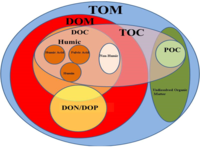
Photo from wikipedia
This study aims to characterize the performance of a 150 L bioelectrochemical system-based plant, during the simultaneous carbon and nitrogen removal from several waste streams of wastewater treatment plants. The bioelectrochemical… Click to show full abstract
This study aims to characterize the performance of a 150 L bioelectrochemical system-based plant, during the simultaneous carbon and nitrogen removal from several waste streams of wastewater treatment plants. The bioelectrochemical system (BES) contained five electrode pairs (operated hydraulically and electrically in parallel) and was fed with either wastewater, centrate (nutrient-rich liquid stream produced during the dewatering of digested biomass), or a mixture of both over 63 days, with a hydraulic retention time of one day. Total organic carbon and total nitrogen removal rates averaged 80% and 70%, respectively, with a specific energy consumption of 0.18 kWh·m-3 (BES + ancillary equipment). This work also underlines the challenges of using BES for nitrogen removal, highlighting the limitations of the current design, and suggesting some strategies for improvement.
Journal Title: Journal of bioscience and bioengineering
Year Published: 2018
Link to full text (if available)
Share on Social Media: Sign Up to like & get
recommendations!